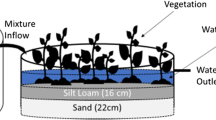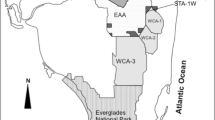Abstract
Phosphate from agricultural runoff is a major contributor to eutrophication in aquatic systems. Vegetated drainage ditches lining agricultural fields have been investigated for their potential to mitigate runoff, acting similarly to a wetland as they filter contaminants. It is hypothesized that some aquatic macrophytes will be more effective at removing phosphate than others. In a mesocosm study, three aquatic macrophyte species, cutgrass (Leersia oryzoides), cattail (Typha latifolia), and bur-reed (Sparganium americanum), were investigated for their ability to mitigate phosphate from water. Mesocosms were exposed to flowing phosphate-enriched water (10 mg L−1) for 6 h, left stagnant for 42 h, and then flushed with non-nutrient enriched water for an additional 6 h to simulate flushing effects of a second storm event. Both L. oryzoides and T. latifolia decreased the load of dissolved phosphate (DP) in outflows by greater than 50 %, significantly more than S. americanum, which only decreased DP by 15 ± 6 % (p ≤ 0.002). All treatments decreased concentrations inside mesocosms by 90 % or more after 1 week, though the decrease occurred more rapidly in T. latifolia and L. oryzoides mesocosms. By discovering which species are better at mitigating phosphate in agricultural runoff, planning the community composition of vegetation in drainage ditches and constructed wetlands can be improved for optimal remediation results.

Similar content being viewed by others
References
Alexander, R. B., Smith, R. A., Schwarz, G. E., Boyer, E. W., Nolan, J. V., & Brakebill, J. W. (2008). Differences in phosphorus and nitrogen delivery to the Gulf of Mexico from the Mississippi River basin. Environmental Science & Technology, 42(3), 822–830.
APHA. (1998). Standard methods for the examination of water and wastewater (20th ed.). Washington, DC: American Public Health Association (APHA).
Brix, H. (1997). Do macrophytes play a role in constructed treatment wetlands? Water Science and Technology, 35, 11–17.
Carpenter, S. R., Caraco, N. F., Correll, D. L., Howarth, R. W., Sharpley, A. N., & Smith, V. H. (1998). Nonpoint pollution of surface waters with phosphorus and nitrogen. Ecological Applications, 8(3), 559–568.
Cooper, C. M., Moore, M. T., Bennett, E. R., Smith, S., Jr., Farris, J. L., Milam, C. D., et al. (2004). Innovative uses of vegetated drainage ditches for reducing agricultural runoff. Water Science and Technology, 49, 117–123.
Deaver, E., Moore, M. T., Cooper, G. M., & Knight, S. S. (2005). Efficiency of three aquatic macrophytes in mitigating nutrient run-off. International Journal of Ecology and Environmental Sciences, 31(1), 1–7.
Faulwetter, J. L., Gagnon, V., Sundberg, C., Chazarenc, F., Burr, M. D., Brisson, J., et al. (2009). Microbial processes influencing performance of treatment wetlands: a review. Ecological Engineering, 35(6), 987–1004.
Gu, B., & Dreschel, T. (2008). Effects of plant community and phosphorus loading rate on constructed wetland performance in Florida, USA. Wetlands, 28(1), 81–91.
Hammer, D. A. (1992). Designing constructed wetlands systems to treat agricultural nonpoint source pollution. Ecological Engineering, 1(1–2), 49–82.
Hey, D. L., Kenimer, A. L., & Barrett, K. R. (1994). Water quality improvement by four experimental wetlands. Ecological Engineering, 3(4), 381–397.
Huang, L., Du, S., Fan, L., Lin, X., Wang, H., & Zhang, Y. (2011). Microbial activity facilitates phosphorus adsorption to shallow lake sediment. Journal of Soils and Sediments, 11(1), 185–193.
Kao, J. T., Titus, J. E., & Zhu, W.-X. (2003). Differential nitrogen and phosphorus retention by five wetland plant species. Wetlands, 23(4), 979–987.
Kröger, R., Holland, M. M., Moore, M. T., & Cooper, C. M. (2007). Plant senescence: a mechanism for nutrient release in temperate agricultural wetlands. Environmental Pollution, 146(1), 114–119.
Kröger, R., Cooper, C. M., & Moore, M. T. (2008a). A preliminary study of an alternative controlled drainage strategy in surface drainage ditches: low-grade weirs. Agricultural Water Management, 95(6), 678–684.
Kröger, R., Holland, M. M., Moore, M. T., & Cooper, C. M. (2008b). Agricultural drainage ditches mitigate phosphorus loads as a function of hydrological variability. Journal of Environmental Quality, 37(1), 107–113.
Martin, J., Hofherr, E., & Quigley, M. F. (2003). Effects of Typha latifolia transpiration and harvesting on nitrate concentrations in surface water of wetland microcosms. Wetlands, 23(4), 835–844.
McDowell, R. W., & Sharpley, A. N. (2003). Uptake and release of phosphorus from overland flow in a stream environment. Journal of Environmental Quality, 32(3), 937–948.
Moore, M. T., Bennett, E. R., Cooper, C. M., Smith, S., Shields, F. D., Milam, C. D., et al. (2001). Transport and fate of atrazine and lambda-cyhalothrin in an agricultural drainage ditch in the Mississippi Delta, USA. Agriculture, Ecosystems & Environment, 87(3), 309–314.
Moore, M. T., Kröger, R., Locke, M. A., Cullum, R. F., Steinriede, R. W., Testa, S., et al. (2010). Nutrient mitigation capacity in Mississippi Delta, USA drainage ditches. Environmental Pollution, 158(1), 175–184.
Murphy, J., & Riley, J. P. (1962). A modified single solution method for the determination of phosphate in natural waters. Analytica Chimica Acta, 27, 31–36.
Ramser, C. E. (1947). Vegetation in drainage ditches causes flooding (p. 9). Lincoln: USDA Soil Conservation Service.
Reddy, K. R., & De Busk, W. F. (1985). Nutrient removal potential of selected aquatic macrophytes. Journal of Environmental Quality, 14(4), 459–462.
Reddy, K. R., Kadlec, R. H., Flaig, E., & Gale, P. M. (1999). Phosphorus retention in streams and wetlands: a review. Critical Reviews in Environmental Science and Technology, 29(1), 83–146.
Richardson, C. J., & Marshall, P. E. (1986). Processes controlling movement, storage, and export of phosphorus in a fen peatland. Ecological Monographs, 56(4), 279–302.
Sharpley, A. N. (1980). The effect of storm interval on the transport of soluble phosphorus in runoff. Journal of Environmental Quality, 9(4), 575–578.
Sharpley, A. N., Krogstad, T., Kleinman, P. J. A., Haggard, B., Shigaki, F., & Saporito, L. S. (2007). Managing natural processes in drainage ditches for nonpoint source phosphorus control. Journal of Soil and Water Conservation, 62(4), 197–206.
Shigaki, F., Kleinman, P. J. A., Schmidt, J. P., Sharpley, A. N., & Allen, A. L. (2008). Impact of dredging on phosphorus transport in agricultural drainage ditches of the Atlantic Coastal Plain. Journal of the American Water Resources Association, 44(6), 1500–1511.
Silvan, N., Vasander, H., & Laine, J. (2004). Vegetation is the main factor in nutrient retention in a constructed wetland buffer. Plant and Soil, 258(1), 179–187.
Tanner, C. C. (1996). Plants for constructed wetland treatment systems—a comparison of the growth and nutrient uptake of eight emergent species. Ecological Engineering, 7(1), 59–83.
US Department of Agriculture. (1991). Southern Wetland Flora: field office guide to plant species. Fort Worth: USDA Soil Conservation Service, South National Technical Center.
Acknowledgments
Special thanks to Lisa Brooks and Wood Dabbs for assistance with sample collection and analysis. Mention of trade names or commercial products is solely for the purpose of providing specific information and does not imply recommendation or endorsement by the US Department of Agriculture (USDA). USDA is an equal opportunity provider and employer.
Author information
Authors and Affiliations
Corresponding author
Electronic supplementary material
Below is the link to the electronic supplementary material.
ESM 1
(PDF 76 kb)
Rights and permissions
About this article
Cite this article
Tyler, H.L., Moore, M.T. & Locke, M.A. Potential for Phosphate Mitigation from Agricultural Runoff by Three Aquatic Macrophytes. Water Air Soil Pollut 223, 4557–4564 (2012). https://doi.org/10.1007/s11270-012-1217-2
Received:
Accepted:
Published:
Issue Date:
DOI: https://doi.org/10.1007/s11270-012-1217-2




